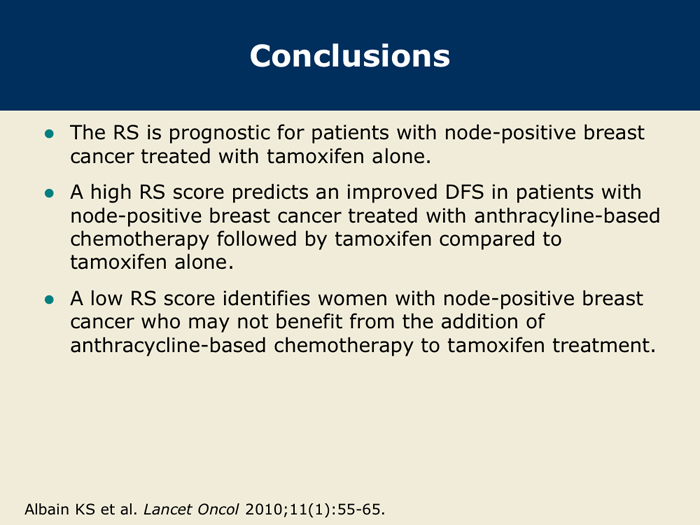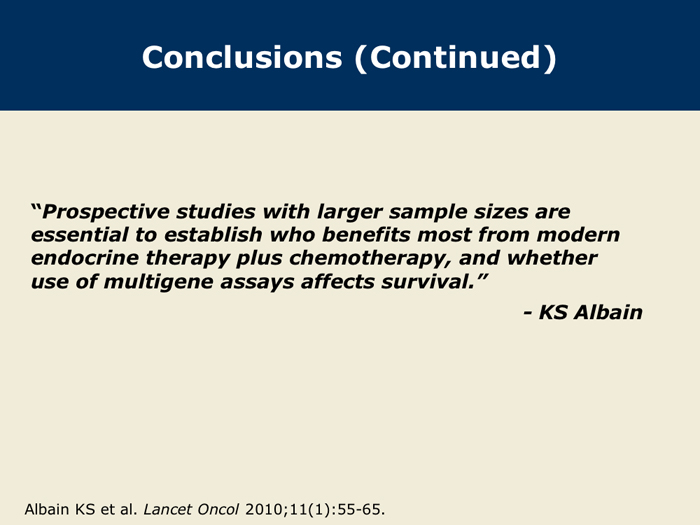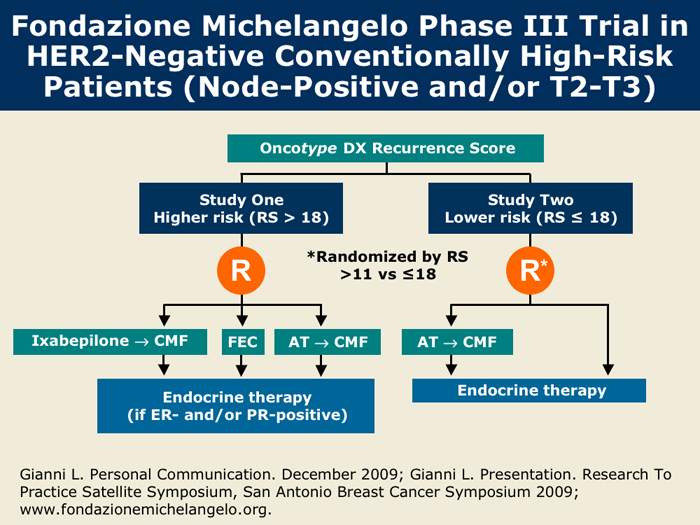
Slide 1 of 9
DR SPARANO: This is an important follow-up of a paper that’s already been presented previously in 2007. There are two principles to keep in mind when examining this paper.
The first is the notion of nodal status as a prognostic factor. Nodal status, unlike Recurrence Score (RS) or some of these other multigene factors, is really a time-dependent variable. Multigene profiles are generally static variables and represent a snapshot of the biology of the disease at that particular moment. The degree of nodal involvement is dependent upon not only the biology of the disease but also on how long the disease has been present. It is also likely a surrogate for the amount of micrometastatic disease present. That has been shown nicely in other work — that patients with node-positive disease have a higher disseminated tumor cell prevalence than patients with node-negative disease.
The second principle is that in the few trials that have examined how well multigene parameters correlate with clinical features, it seems that the two correlate very poorly with each other. What that indicates is that they’re really measuring different things.

Slide 3 of 9
DR SPARANO: The parent SWOG-8814 trial targeted postmenopausal women who had node-positive, ER-positive disease. They were randomly assigned to tamoxifen versus tamoxifen plus CAF chemotherapy, either concurrently or sequentially, followed by tamoxifen. This analysis was restricted to those who were assigned to tamoxifen alone versus CAF followed sequentially by tamoxifen, which was an arm that did better than the concurrent tamoxifen arm. They examined a subset of patients enrolled in the trial, about 40 percent of the parent trial, a relatively small sample size of 367 patients.

Slide 6 of 9
DR BRUFSKY: The RS was a greater predictor than anything else examined — greater than having one to three positive nodes, greater than having four positive nodes. That is the main finding of this paper. In the low-RS subset of women with node-positive disease, no matter how many positive nodes they have, patients are just not going to benefit from receiving chemotherapy, and these patients appear to obtain substantial benefit just from hormonal therapy.
DR SPARANO: The results were similar to what had been previously reported in the B-20 trial, which looked at patients with ER-positive, node-negative disease treated with tamoxifen or tamoxifen plus CMF. The benefit of chemotherapy seemed to be restricted to those who had a high RS. A statistically significant benefit was not seen in those who had a low RS or an intermediate RS, although in both studies there seemed to be a slight trend favoring the use of chemotherapy in that group.

Slide 7 of 9
DR BRUFSKY: The take-home message for me as an oncologist is that I am going to do this assay on women with node-positive breast cancer, at least postmenopausal women. The typical kind of woman who you’re going to see as a patient — around 65 to 70 years old with ER-positive breast cancer and two or three positive nodes — should have this assay done in my opinion. There are also the patients who are strongly averse to chemotherapy. If you perform the Oncotype DX® assay on these patients and they have a low RS of less than 18, you now have some data to support administering only endocrine therapy. The results of this study reinforce that.

Slide 8 of 9
DR SPARANO: I think this study provides reassurance that the RS can be potentially useful for patients who have node-positive disease, and it might be useful in selecting individuals who may not benefit from chemotherapy. We are talking about a small data set, however, and it would be reassuring to see more data.
Now that the approval for the Oncotype DX assay has been expanded to include patients who have node-positive disease, it makes me feel more comfortable about using the assay in older patients who have low-volume node-positive disease and using the assay as a means to spare administering chemotherapy to patients to whom I would have otherwise recommended chemotherapy.



